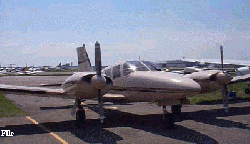Airplane Was More Than 300 Pounds Over Gross Weight
 The NTSB has released its factual
report on a January, 2009 accident in West Virginia that killed a
pilot and five passengers on a cross-country flight from Lake
in the Hills, Illinois to Huntington, WV.
The NTSB has released its factual
report on a January, 2009 accident in West Virginia that killed a
pilot and five passengers on a cross-country flight from Lake
in the Hills, Illinois to Huntington, WV.
According to the NTSB report, on January 30, 2009 at 1336 EST, a
Piper PA-34-200T, N8047C, was destroyed when it struck high-tension
power lines and collided with terrain while maneuvering for landing
at the Huntington Tri-State Airport (HTS), Huntington, West
Virginia. The certificated private pilot, a certificated student
pilot, and four passengers were fatally injured. Instrument
meteorological conditions (IMC) prevailed, and no flight plan was
filed for the flight which departed Lake in the Hills Airport
(3CK), Lake in the Hills, Illinois, about 1000.
According to a friend of the pilot, the purpose of the flight
was to look at airplanes for sale at Raleigh-Durham, North
Carolina, and Clearwater, Florida. The friend had been asked to go
along, but could not due to a scheduling conflict. On the day of
the accident, the friend noticed there were six people on the
airplane instead of the planned five, asked about weight and
balance, and the pilot assured him that he had completed the proper
calculations. The friend further advised the pilot to obtain a
weather briefing and file a flight plan before departure. The pilot
assured his friend that he would obtain a briefing and file a
flight plan from the airplane using his cellular telephone.
According to the fixed base operator, the airplane was "topped off"
with 68.3 gallons of fuel prior to departure.
The accident airplane approached HTS from the southwest and the
pilot contacted air traffic control shortly after 1300 by
transmitting a "mayday" call. The pilot advised the controller,
"I'm flying VFR, low on fuel, and need to land." The controller
asked the pilot if he was capable of instrument flight, and the
pilot responded, "ah, yes."
During the next 30 minutes, the controller attempted to vector
the airplane for an airport surveillance radar (ASR) approach,
provide VFR vectors when the pilot announced he had "ground
contact," and ultimately, a no-gyro ASR approach. At no time did
the accident airplane acquire or maintain any of the altitudes or
headings assigned by the controller.
The pilot was largely unresponsive to the controller's requests
and instructions, and on occasion, other pilots on the frequency
would relay the instructions, also with no response. The controller
issued several low altitude alert warnings, and at one point asked
the pilot to "maintain any heading. Level your wings, and maintain
any heading." When asked again if he was capable of instrument
flight, the pilot replied, "No." When radar contact was lost, the
airplane was 4 miles southwest of the airport, on a heading of
about 120 degrees.

File Photo
The pilot held a private pilot certificate with ratings for
airplane single engine and multiengine land, as well as glider. The
pilot's logbook was not recovered; therefore his total flight
experience could not be determined. His most recent FAA second
class medical certificate was issued on December 17, 2008, and the
pilot reported 2,200 total hours of flight experience on that date.
The pilot did not possess an instrument rating.
Weight and balance calculations were performed using weight and
balance documents recovered at the site, the actual weights of the
occupants, and the baggage recovered at the scene. Calculations
revealed the airplane weighed about 4,902 pounds at takeoff, with a
center of gravity at 98.40 inches aft of datum. The zero fuel
weight was calculated at 4,343.9 pounds, at 99.02 inches aft of
datum. The manufacturer's center of gravity range at maximum gross
weight was 90.6 to 95 inches aft of datum. The manufacturer's
maximum allowable gross weight was 4,570 pounds.
 Airborne 06.30.25: US v ADS-B Misuse, Natl STOL Fire, Volocopter Resumes
Airborne 06.30.25: US v ADS-B Misuse, Natl STOL Fire, Volocopter Resumes NTSB Prelim: Piper PA-23
NTSB Prelim: Piper PA-23 ANN FAQ: Submit a News Story!
ANN FAQ: Submit a News Story! Classic Aero-TV: One Mans Vietnam
Classic Aero-TV: One Mans Vietnam Klyde Morris (06.30.25)
Klyde Morris (06.30.25)




